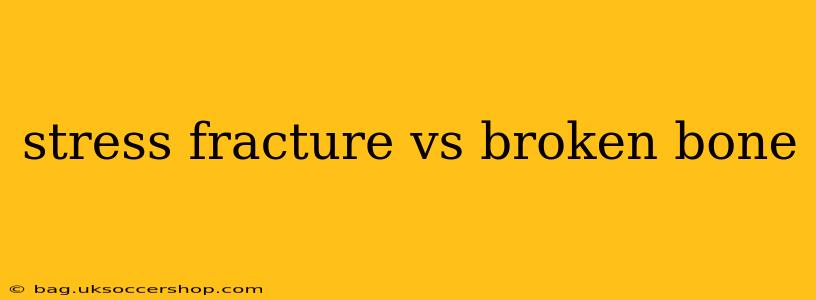A stress fracture and a broken bone (also called a fracture) might seem similar at first glance, both causing pain and potentially limiting mobility. However, there are crucial differences in how they occur, their severity, and their healing process. Understanding these distinctions is vital for proper diagnosis and treatment.
What is a Stress Fracture?
A stress fracture is a tiny crack in a bone, typically caused by repetitive, low-impact forces over time. Think of a runner logging many miles each week, a dancer repeatedly executing jumps, or a soldier marching long distances. These activities gradually weaken the bone, leading to a hairline crack. Unlike a broken bone resulting from a single traumatic event, a stress fracture develops insidiously. The pain often starts subtly and gradually worsens.
What is a Broken Bone (Fracture)?
A broken bone, or fracture, is a complete or incomplete break in the bone structure caused by a single high-impact force. This could be anything from a fall, a car accident, a direct blow, or a sudden, forceful twisting motion. Fractures are generally more severe than stress fractures, often resulting in significant pain, swelling, and deformity. The broken bone may be visibly displaced (out of alignment) or even pierce the skin (an open fracture).
How are Stress Fractures and Broken Bones Diagnosed?
Diagnosing both conditions often involves a physical examination and imaging tests. A doctor will assess your medical history, the nature of your pain, and the location of the injury. X-rays are frequently used to visualize both stress fractures and fractures, though stress fractures can be difficult to detect in early stages with X-rays because the crack may be too small. In these cases, other imaging techniques like bone scans or MRI scans may be necessary for confirmation.
What are the Symptoms of a Stress Fracture vs. a Broken Bone?
While both can cause pain, the symptoms differ in severity and onset:
Stress Fracture:
- Gradual onset of pain: Pain usually starts subtly and increases gradually with activity.
- Localized pain: Pain is typically concentrated over the affected bone.
- Swelling may be minimal: Significant swelling is less common compared to a fracture.
- Pain at rest may be minimal: Pain may be present during activity but subside with rest.
Broken Bone:
- Sudden onset of severe pain: Pain is intense and immediate after the injury.
- Swelling and bruising: Significant swelling and bruising are common.
- Deformity: The injured area may appear deformed or out of alignment.
- Loss of function: The injured limb or area may be difficult or impossible to use.
What is the Treatment for a Stress Fracture vs. a Broken Bone?
Treatment depends on the severity of the injury and the location of the fracture or stress fracture.
Stress Fracture Treatment:
- Rest: Avoiding activities that stress the bone is crucial.
- Immobilization: A cast or brace may be used to restrict movement.
- Pain relief: Over-the-counter pain relievers (like ibuprofen or acetaminophen) can help manage pain and inflammation.
- Physical therapy: Strengthening exercises may be recommended once the bone has healed to prevent future stress fractures.
Broken Bone Treatment:
- Immobilization: A cast, splint, or external fixation device is often needed to stabilize the broken bone.
- Surgery: In some cases, surgery may be necessary to realign the bone fragments (reduction) and hold them in place (internal fixation).
- Pain relief: Stronger pain medications may be required due to the severity of the pain.
- Physical therapy: Post-surgery and fracture healing physical therapy is crucial for regaining strength and mobility.
How Long Does it Take for a Stress Fracture vs. a Broken Bone to Heal?
Healing times vary depending on several factors, including the severity of the injury, the location of the fracture, and the individual's overall health.
Stress Fracture Healing: Generally heals within 6-8 weeks with proper rest and treatment.
Broken Bone Healing: Can take anywhere from several weeks to several months, depending on the type and location of the fracture. Some fractures may require longer healing times.
Can you have a stress fracture without knowing it?
Yes, it's possible. The pain from a stress fracture can be mild and easily dismissed initially, especially if the individual is used to some degree of discomfort from activity. If the pain is ignored or improperly treated, the fracture could worsen, potentially leading to a complete break.
What are the risk factors for stress fractures and broken bones?
Several factors can increase the risk of both stress fractures and broken bones. These include:
- Low bone density (osteoporosis): Increases the risk of both conditions.
- Improper training techniques: Overtraining or sudden increases in activity intensity can contribute to stress fractures.
- Inadequate nutrition: Insufficient calcium and vitamin D intake weakens bones.
- Certain medical conditions: Some medical conditions, like hyperthyroidism, can increase fracture risk.
- Falls or accidents: Traumatic events are the primary cause of broken bones.
- Age: Older adults are at higher risk of fractures due to age-related bone loss.
This information is intended for general knowledge and does not constitute medical advice. Always consult with a healthcare professional for diagnosis and treatment of any bone injury. They can accurately assess your situation and recommend the most appropriate course of action.
